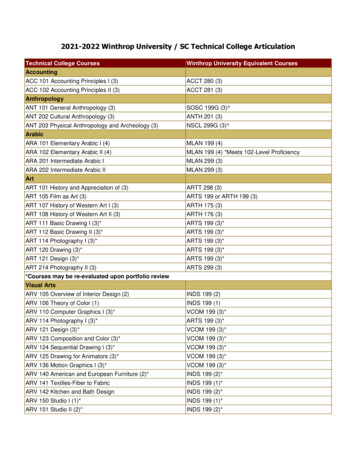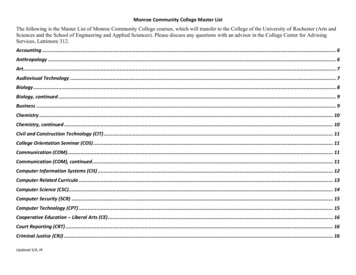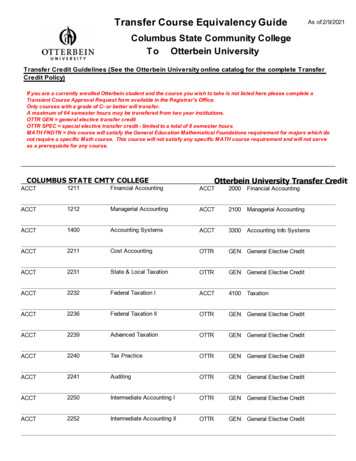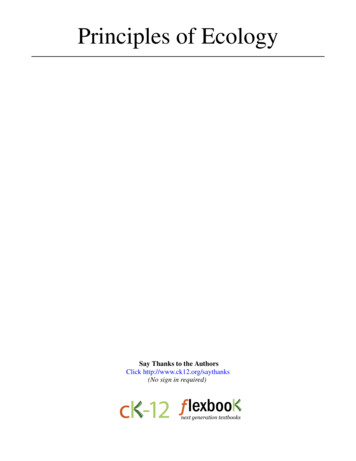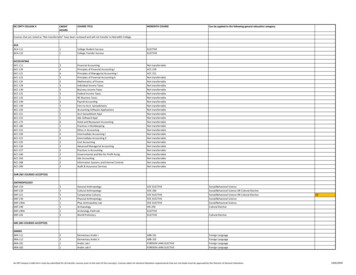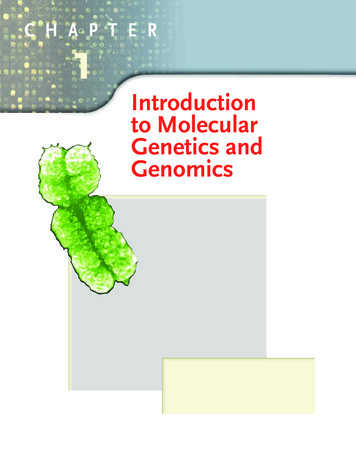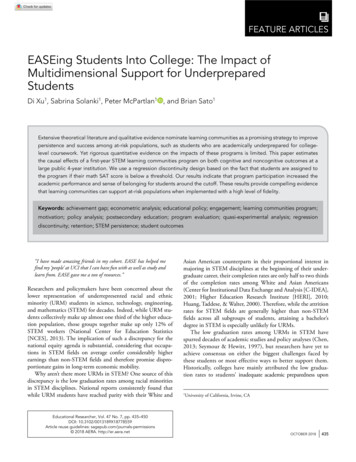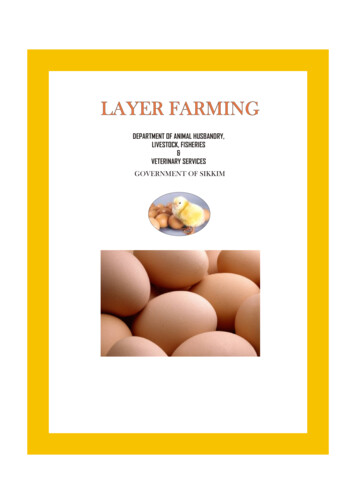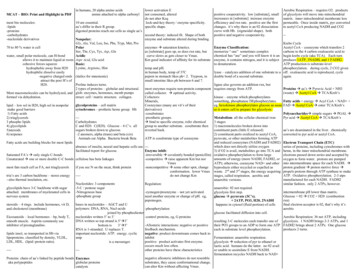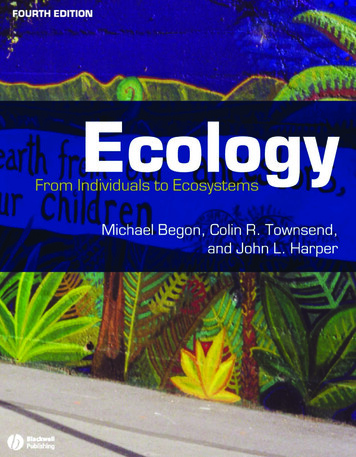
Transcription
ECOLOGYFrom Individuals to Ecosystems
ECOLOGYFrom Individuals to EcosystemsMICHAEL BEGONSchool of Biological Sciences,The University of Liverpool, Liverpool, UKCOLIN R. TOWNSENDDepartment of Zoology, University of Otago, Dunedin, New ZealandJOHN L. HARPERChapel Road, Brampford Speke, Exeter, UKFOURTH EDITION
1986, 1990, 1996, 2006 by Blackwell Publishing LtdBLACKWELL PUBLISHING350 Main Street, Malden, MA 02148-5020, USA9600 Garsington Road, Oxford OX4 2DQ, UK550 Swanston Street, Carlton, Victoria 3053, AustraliaThe right of Mike Begon, Colin Townsend and John Harper to be identified as the Authors of this Work has beenasserted in accordance with the UK Copyright, Designs and Patents Act 1988.All rights reserved. No part of this publication may be reproduced, stored in a retrieval system, or transmitted, in anyform or by any means, electronic, mechanical, photocopying, recording or otherwise, except as permitted by the UK Copyright,Designs, and Patents Act 1988, without the prior permission of the publisherFirst edition published 1986 by Blackwell Publishing LtdSecond edition published 1990Third edition published 1996Fourth edition published 20061 2006Library of Congress Cataloging-in-Publication DataBegon, Michael.Ecology : from individuals to ecosystems / Michael Begon, Colin R.Townsend, John L. Harper.— 4th ed.p.cm.Includes bibliographical references and index.ISBN-13: 978-1-4051-1117-1 (hard cover : alk. paper)ISBN-10: 1-4051-1117-8 (hard cover : alk. paper)1. Ecology. I. Townsend, Colin R. II. Harper, John L. III. Title.QH54.B416 2005577— dc222005004136A catalogue record for this title is available from the British Library.Set in 9.5/12 Dante MTby Graphicraft Limited, Hong KongPrinted and bound in the United Kingdomby CPI Bath PressThe publisher’s policy is to use permanent paper from mills that operate a sustainable forestry policy,and which has been manufatured from pulp processed using acid-free and elementary chlorine-free practices.Furthermore, the publisher ensures that the text paper and cover board used have met acceptable environmentalaccreditation standards.For further information onBlackwell Publishing, visit our website:www.blackwellpublishing.com
ContentsPreface, viiIntroduction: Ecology and its Domain, xiPart 1: Organisms1 Organisms in their Environments: the Evolutionary Backdrop, 32 Conditions, 303 Resources, 584 Life, Death and Life Histories, 895 Intraspecific Competition, 1326 Dispersal, Dormancy and Metapopulations, 1637 Ecological Applications at the Level of Organisms and Single-Species Populations: Restoration, Biosecurityand Conservation, 186Part 2: Species Interactions8 Interspecific Competition, 2279 The Nature of Predation, 26610The Population Dynamics of Predation, 29711Decomposers and Detritivores, 32612Parasitism and Disease, 34713Symbiosis and Mutualism, 38114Abundance, 41015Ecological Applications at the Level of Population Interactions: Pest Control and Harvest Management, 439
viCONTENTSPart 3: Communities and Ecosystems16The Nature of the Community: Patterns in Space and Time, 46917The Flux of Energy through Ecosystems, 49918The Flux of Matter through Ecosystems, 52519The Influence of Population Interactions on Community Structure, 55020Food Webs, 57821Patterns in Species Richness, 60222Ecological Applications at the Level of Communities and Ecosystems: Management Based on the Theory ofSuccession, Food Webs, Ecosystem Functioning and Biodiversity, 633References, 659Organism Index, 701Subject Index, 714Color plate section between pp. 000 and 000
PrefaceA science for everybody – but not an easy scienceThis book is about the distribution and abundance of differenttypes of organism, and about the physical, chemical but especiallythe biological features and interactions that determine thesedistributions and abundances.Unlike some other sciences, the subject matter of ecology isapparent to everybody: most people have observed and ponderednature, and in this sense most people are ecologists of sorts. Butecology is not an easy science. It must deal explicitly with threelevels of the biological hierarchy – the organisms, the populationsof organisms, and the communities of populations – and, aswe shall see, it ignores at its peril the details of the biology ofindividuals, or the pervading influences of historical, evolutionary and geological events. It feeds on advances in our knowledgeof biochemistry, behavior, climatology, plate tectonics and so on,but it feeds back to our understanding of vast areas of biologytoo. If, as T. H. Dobzhansky said, ‘Nothing in biology makessense, except in the light of evolution’, then, equally, very littlein evolution, and hence in biology as a whole, makes senseexcept in the light of ecology.Ecology has the distinction of being peculiarly confrontedwith uniqueness: millions of different species, countless billionsof genetically distinct individuals, all living and interacting in avaried and ever-changing world. The challenge of ecology is todevelop an understanding of very basic and apparent problems,in a way that recognizes this uniqueness and complexity, but seekspatterns and predictions within this complexity rather than beingswamped by it. As L. C. Birch has pointed out, Whitehead’s recipefor science is never more apposite than when applied to ecology:seek simplicity, but distrust it.Nineteen years on: applied ecology hascome of ageThis fourth edition comes fully 9 years after its immediate predecessor and 19 years after the first edition. Much has changed –in ecology, in the world around us, and even (strange to report!)in we authors. The Preface to the first edition began: ‘As the cavepainting on the front cover of this book implies, ecology, if notthe oldest profession, is probably the oldest science’, followed bya justification that argued that the most primitive humans had tounderstand, as a matter of necessity, the dynamics of the environment in which they lived. Nineteen years on, we have tried tocapture in our cover design both how much and how little haschanged. The cave painting has given way to its modern equivalent: urban graffiti. As a species, we are still driven to broadcastour feelings graphically and publicly for others to see. Butsimple, factual depictions have given way to urgent statementsof frustration and aggression. The human subjects are no longermere participants but either perpetrators or victims.Of course, it has taken more than 19 years to move fromman-the-cave-painter to man-the-graffiti-artist. But 19 years agoit seemed acceptable for ecologists to hold a comfortable, objective, not to say aloof position, in which the animals and plantsaround us were simply material for which we sought a scientificunderstanding. Now, we must accept the immediacy of theenvironmental problems that threaten us and the responsibilityof ecologists to come in from the sidelines and play their full partin addressing these problems. Applying ecological principles is notonly a practical necessity, but also as scientifically challenging asderiving those principles in the first place, and we have includedthree new ‘applied’ chapters in this edition, organized around the
viiiPREFACEthree sections of the book: applications at the level of individualorganisms and of single-species populations, of species interactions, and of whole communities and ecosystems. But weremain wedded to the belief that environmental action can onlyever be as sound as the ecological principles on which it is based.Hence, while the remaining chapters are still largely about theprinciples themselves rather than their application, we believe thatthe whole of this book is aimed at improving preparedness foraddressing the environmental problems of the new millennium.Ecology’s ecological nicheWe would be poor ecologists indeed if we did not believe thatthe principles of ecology apply to all facets of the world aroundus and all aspects of human endeavor. So, when we wrote the firstedition of Ecology, it was a generalist book, designed to overcomethe opposition of all competing textbooks. Much more recently,we have been persuaded to use our ‘big book’ as a springboardto produce a smaller, less demanding text, Essentials of Ecology (alsopublished by Blackwell Publishing!), aimed especially at the firstyear of a degree program and at those who may, at that stage,be taking the only ecology course they will ever take.This, in turn, has allowed us to engineer a certain amount of‘niche differentiation’. With the first years covered by Essentials,we have been freer to attempt to make this fourth edition an upto-date guide to ecology now (or, at least, when it was written).To this end, the results from around 800 studies have beennewly incorporated into the text, most of them published sincethe third edition. None the less, we have shortened the text byaround 15%, mindful that for many, previous editions havebecome increasingly overwhelming, and that, clichéd as it maybe, less is often more. We have also consciously attempted,while including so much modern work, to avoid bandwagons thatseem likely to have run into the buffers by the time many willbe using the book. Of course, we may also, sadly, have excludedbandwagons that go on to fulfil their promise.Having said this, we hope, still, that this edition will be of valueto all those whose degree program includes ecology and all whoare, in some way, practicing ecologists. Certain aspects of thesubject, particularly the mathematical ones, will prove difficult forsome, but our coverage is designed to ensure that wherever ourreaders’ strengths lie – in the field or laboratory, in theory or inpractice – a balanced and up-to-date view should emerge.Different chapters of this book contain different proportionsof descriptive natural history, physiology, behavior, rigorouslaboratory and field experimentation, careful field monitoringand censusing, and mathematical modeling (a form of simplicitythat it is essential to seek but equally essential to distrust). Thesevarying proportions to some extent reflect the progress made indifferent areas. They also reflect intrinsic differences in variousaspects of ecology. Whatever progress is made, ecology willremain a meeting-ground for the naturalist, the experimentalist,the field biologist and the mathematical modeler. We believe thatall ecologists should to some extent try to combine all these facets.Technical and pedagogical featuresOne technical feature we have retained in the book is the incorporation of marginal es as signposts throughout the text. These,we hope, will serve a number of purposes. In the first place, theyconstitute a series of subheadings highlighting the detailed structure of the text. However, because they are numerous and ofteninformative in their own right, they can also be read in sequencealong with the conventional subheadings, as an outline of eachchapter. They should act too as a revision aid for students – indeed,they are similar to the annotations that students themselvesoften add to their textbooks. Finally, because the marginal notesgenerally summarize the take-home message of the paragraphor paragraphs that they accompany, they can act as a continuousassessment of comprehension: if you can see that the signpostis the take-home message of what you have just read, then youhave understood. For this edition, though, we have also addeda brief summary to each chapter, that, we hope, may allowreaders to either orient and prepare themselves before theyembark on the chapter or to remind themselves where theyhave just been.So: to summarize and, to a degree, reiterate some key featuresof this fourth edition, they are: marginal notes throughout the textsummaries of all chaptersaround 800 newly-incorporated studiesthree new chapters on applied ecologya reduction in overall length of around 15%a dedicated website (www.blackwellpublishing.com/begon),twinned with that for Essentials of Ecology, including interactive mathematical models, an extensive glossary, copies ofartwork in the text, and links to other ecological sites an up-dating and redrawing of all artwork, which is also available to teachers on a CD-ROM for ease of incorporation intolecture material.AcknowledgementsFinally, perhaps the most profound alteration to the constructionof this book in its fourth edition is that the revision has been thework of two rather than three of us. John Harper has very reasonably decided that the attractions of retirement and grandfatherhood outweigh those of textbook co-authorship. For the twoof us who remain, there is just one benefit: it allows us to recordpublicly not only what a great pleasure it has been to have
PREFACEcollaborated with John over so many years, but also just how muchwe learnt from him. We cannot promise to have absorbed or, tobe frank, to have accepted, every one of his views; and we hopein particular, in this fourth edition, that we have not strayed toofar from the paths through which he has guided us. But if readersrecognize any attempts to stimulate and inspire rather thansimply to inform, to question rather than to accept, to respectour readers rather than to patronize them, and to avoid unquestioning obedience to current reputation while acknowledgingour debt to the masters of the past, then they will have identifiedJohn’s intellectual legacy still firmly imprinted on the text.In previous editions we thanked the great many friendsand colleagues who helped us by commenting on various draftsof the text. The effects of their contributions are still stronglyevident in the present edition. This fourth edition was also readby a series of reviewers, to whom we are deeply grateful. Severalremained anonymous and so we cannot thank them by name,ixbut we are delighted to be able to acknowledge the help ofJonathan Anderson, Mike Bonsall, Angela Douglas, ChrisElphick, Valerie Eviner, Andy Foggo, Jerry Franklin, KevinGaston, Charles Godfray, Sue Hartley, Marcel Holyoak, JimHone, Peter Hudson, Johannes Knops, Xavier Lambin, SvataLouda, Peter Morin, Steve Ormerod, Richard Sibly, AndrewWatkinson, Jacob Weiner, and David Wharton. At Blackwell,and in the production stage, we were particularly helped andencouraged by Jane Andrew, Elizabeth Frank, Rosie Hayden, DeliaSandford and Nancy Whilton.This book is dedicated to our families – by Mike to Linda, Jessicaand Robert, and by Colin to Laurel, Dominic, Jenny andBrennan, and especially to the memory of his mother, JeanEvelyn Townsend.Mike BegonColin Townsend
Introduction: Ecology andits DomainDefinition and scope of ecologyThe word ‘ecology’ was first used by Ernest Haeckel in 1869.Paraphrasing Haeckel we can describe ecology as the scientificstudy of the interactions between organisms and their environment. The word is derived from the Greek oikos, meaning‘home’. Ecology might therefore be thought of as the study ofthe ‘home life’ of living organisms. A less vague definition wassuggested by Krebs (1972): ‘Ecology is the scientific study ofthe interactions that determine the distribution and abundanceof organisms’. Notice that Krebs’ definition does not use the word‘environment’; to see why, it is necessary to define the word.The environment of an organism consists of all those factors andphenomena outside the organism that influence it, whether theseare physical and chemical (abiotic) or other organisms (biotic). The‘interactions’ in Krebs’ definition are, of course, interactions withthese very factors. The environment therefore retains the centralposition that Haeckel gave it. Krebs’ definition has the merit ofpinpointing the ultimate subject matter of ecology: the distribution and abundance of organisms – where organisms occur, howmany occur there, and why. This being so, it might be better stillto define ecology as:the scientific study of the distribution and abundance oforganisms and the interactions that determine distributionand abundance.As far as the subject matter of ecology is concerned, ‘thedistribution and abundance of organisms’ is pleasantly succinct.But we need to expand it. The living world can be viewed as abiological hierarchy that starts with subcellular particles, andcontinues up through cells, tissues and organs. Ecology dealswith the next three levels: the individual organism, the population(consisting of individuals of the same species) and the community(consisting of a greater or lesser number of species populations).At the level of the organism, ecology deals with how individualsare affected by (and how they affect) their environment. At thelevel of the population, ecology is concerned with the presenceor absence of particular species, their abundance or rarity, andwith the trends and fluctuations in their numbers. Communityecology then deals with the composition and organization ofecological communities. Ecologists also focus on the pathwaysfollowed by energy and matter as these move among livingand nonliving elements of a further category of organization:the ecosystem, comprising the community together with itsphysical environment. With this in mind, Likens (1992) wouldextend our preferred definition of ecology to include ‘theinteractions between organisms and the transformation andflux of energy and matter’. However, we take energy/mattertransformations as being subsumed in the ‘interactions’ of ourdefinition.There are two broad approaches that ecologists can take ateach level of ecological organization. First, much can be gainedby building from properties at the level below: physiology whenstudying organismal ecology; individual clutch size and survivalprobabilities when investigating the dynamics of individual speciespopulations; food consumption rates when dealing with interactions between predator and prey populations; limits to thesimilarity of coexisting species when researching communities, andso on. An alternative approach deals directly with properties ofthe level of interest – for example, niche breadth at the organismal level; relative importance of density-dependent processes atthe population level; species diversity at the level of community;rate of biomass production at the ecosystem level – and tries torelate these to abiotic or biotic aspects of the environment. Bothapproaches have their uses, and both will be used in each of thethree parts of this book: Organisms; Species Interactions; andCommunities and Ecosystems.
xiiINTRODUCTION: ECOLOGY AND ITS DOMAINExplanation, description, prediction and controlAt all levels of ecological organization we can try to do a number of different things. In the first place we can try to explain orunderstand. This is a search for knowledge in the pure scientifictradition. In order to do this, however, it is necessary first to describe.This, too, adds to our knowledge of the living world. Obviously,in order to understand something, we must first have a description of whatever it is that we wish to understand. Equally, butless obviously, the most valuable descriptions are those carriedout with a particular problem or ‘need for understanding’ in mind.All descriptions are selective: but undirected description, carriedout for its own sake, is often found afterwards to have selectedthe wrong things.Ecologists also often try to predict what will happen to anorganism, a population, a community or an ecosystem under aparticular set of circumstances: and on the basis of these predictions we try to control the situation. We try to minimize the effectsof locust plagues by predicting when they are likely to occur andtaking appropriate action. We try to protect crops by predictingwhen conditions will be favorable to the crop and unfavorableto its enemies. We try to maintain endangered species bypredicting the conservation policy that will enable them topersist. We try to conserve biodiversity to maintain ecosystem‘services’ such as the protection of chemical quality of naturalwaters. Some prediction and control can be carried out withoutexplanation or understanding. But confident predictions, precisepredictions and predictions of what will happen in unusualcircumstances can be made only when we can explain what isgoing on. Mathematical modeling has played, and will continueto play, a crucial role in the development of ecology, particularlyin our ability to predict outcomes. But it is the real world we areinterested in, and the worth of models must always be judged interms of the light they shed on the working of natural systems.It is important to realize that there are two different classesof explanation in biology: proximal and ultimate explanations. Forexample, the present distribution and abundance of a particularspecies of bird may be ‘explained’ in terms of the physical environment that the bird tolerates, the food that it eats and the parasites and predators that attack it. This is a proximal explanation.However, we may also ask how this species of bird comes to havethese properties that now appear to govern its life. This questionhas to be answered by an explanation in evolutionary terms. Theultimate explanation of the present distribution and abundance ofthis bird lies in the ecological experiences of its ancestors. Thereare many problems in ecology that demand evolutionary, ultimateexplanations: ‘How have organisms come to possess particularcombinations of size, developmental rate, reproductive output andso on?’ (Chapter 4), ‘What causes predators to adopt particularpatterns of foraging behavior?’ (Chapter 9) and ‘How does it comeabout that coexisting species are often similar but rarely thesame?’ (Chapter 19). These problems are as much part of modernecology as are the prevention of plagues, the protection of cropsand the preservation of rare species. Our ability to control andexploit ecosystems cannot fail to be improved by an ability toexplain and understand. And in the search for understanding, wemust combine both proximal and ultimate explanations.Pure and applied ecologyEcologists are concerned not only with communities, populationsand organisms in nature, but also with manmade or humaninfluenced environments (plantation forests, wheat fields, grainstores, nature reserves and so on), and with the consequencesof human influence on nature (pollution, overharvesting, globalclimate change). In fact, our influence is so pervasive that we wouldbe hard pressed to find an environment that was totally unaffectedby human activity. Environmental problems are now high on thepolitical agenda and ecologists clearly have a central role to play:a sustainable future depends fundamentally on ecological understanding and our ability to predict or produce outcomes underdifferent scenarios.When the first edition of this text was published in 1986, themajority of ecologists would have classed themselves as purescientists, defending their right to pursue ecology for its own sakeand not wishing to be deflected into narrowly applied projects.The situation has changed dramatically in 20 years, partly becausegovernments have shifted the focus of grant-awarding bodiestowards ecological applications, but also, and more fundamentally,because ecologists have themselves responded to the need to directmuch of their research to the many environmental problems thathave become ever more pressing. This is recognized in this newedition by a systematic treatment of ecological applications – eachof the three sections of the book concludes with an appliedchapter. We believe strongly that the application of ecologicaltheory must be based on a sophisticated understanding of the purescience. Thus, our ecological application chapters are organizedaround the ecological understanding presented in the earlierchapters of each section.
Part 1OrganismsIntroductionWe have chosen to start this book with chapters about organisms, then to consider the ways in which they interact with eachother, and lastly to consider the properties of the communitiesthat they form. One could call this a ‘constructive’ approach. Wecould though, quite sensibly, have treated the subject the otherway round – starting with a discussion of the complex communities of both natural and manmade habitats, proceeding todeconstruct them at ever finer scales, and ending with chapterson the characteristics of the individual organisms – a moreanalytical approach. Neither is ‘correct’. Our approach avoidshaving to describe community patterns before discussing thepopulations that comprise them. But when we start with individualorganisms, we have to accept that many of the environmentalforces acting on them, especially the species with which theycoexist, will only be dealt with fully later in the book.This first section covers individual organisms and populationscomposed of just a single species. We consider initially the sortsof correspondences that we can detect between organisms andthe environments in which they live. It would be facile to startwith the view that every organism is in some way ideally fittedto live where it does. Rather, we emphasize in Chapter 1 thatorganisms frequently are as they are, and live where they do,because of the constraints imposed by their evolutionary history.All species are absent from almost everywhere, and we considernext, in Chapter 2, the ways in which environmental conditionsvary from place to place and from time to time, and how theseput limits on the distribution of particular species. Then, inChapter 3, we look at the resources that different types oforganisms consume, and the nature of their interactions withthese resources.The particular species present in a community, and theirabundance, give that community much of its ecological interest.Abundance and distribution (variation in abundance from placeto place) are determined by the balance between birth, death, immigration and emigration. In Chapter 4 we consider some of thevariety in the schedules of birth and death, how these may bequantified, and the resultant patterns in ‘life histories’: lifetimeprofiles of growth, differentiation, storage and reproduction. InChapter 5 we examine perhaps the most pervasive interactionacting within single-species populations: intraspecific competitionfor shared resources in short supply. In Chapter 6 we turn to movement: immigration and emigration. Every species of plant andanimal has a characteristic ability to disperse. This determines therate at which individuals escape from environments that are orbecome unfavorable, and the rate at which they discover sitesthat are ripe for colonization and exploitation. The abundanceor rarity of a species may be determined by its ability to disperse(or migrate) to unoccupied patches, islands or continents. Finallyin this section, in Chapter 7, we consider the application of theprinciples that have been discussed in the preceding chapters, including niche theory, life history theory, patterns of movement, andthe dynamics of small populations, paying particular attentionto restoration after environmental damage, biosecurity (resistingthe invasion of alien species) and species conservation.
Chapter 1Organisms intheir Environments:the Evolutionary Backdrop1.1 Introduction: natural selection andadaptationFrom our definition of ecology in the Preface, and even from alayman’s understanding of the term, it is clear that at the heartof ecology lies the relationship between organisms and theirenvironments. In this opening chapter we explain how, fundamentally, this is an evolutionary relationship. The great Russian–American biologist Theodosius Dobzhansky famously said:‘Nothing in biology makes sense, except in the light of evolution’.This is as true of ecology as of any other aspect of biology. Thus,we try here to explain the processes by which the propertiesof different sorts of species make their life possible in particularenvironments, and also to explain their failure to live in otherenvironments. In mapping out this evolutionary backdrop to thesubject, we will also be introducing many of the questions thatare taken up in detail in later chapters.The phrase that, in everyday speech, is most commonly usedto describe the match between organisms and environment is:‘organism X is adapted to’ followed by a description of where theorganism is found. Thus, we often hear that ‘fish are adapted tolive in water’, or ‘cacti are adapted to live in conditions of drought’.In everyday speech, this may mean very little: simply that fish havecharacteristics that allow them to live in water (and perhaps excludethem from other environments) or that cacti have characteristicsthat allow them to live where water is scarce. The word ‘adapted’here says nothing about how the characteristics were acquired.For an ecologist or evolutionarythe meaning ofbiologist, however, ‘X is adapted toadaptationlive in Y’ means that environment Y hasprovided forces of natural selectionthat have affected the life of X’s ancestors and so have moldedand specialized the evolution of X. ‘Adaptation’ means thatgenetic change has occurred.Regrettably, though, the word ‘adaptation’ implies thatorganisms are matched to their present environments, suggest-ing ‘design’ or even ‘prediction’. But organisms have not beendesigned for, or fitted to the present: they have been molded(by natural selection) by past environments. Their characteristicsreflect the successes and failures of ancestors. They appear tobe apt for the environments that they live in at present onlybecause present environments tend to be similar to those ofthe past.The theory of evolution by natural selection is an ecologicaltheory. It was first elaborated by Charles Darwin (1859), thoughits essence was also appreciated by a contemporary and correspondent of Darwin’s, Alfred Russellevolution by naturalWallace (Figure 1.1). It rests on a seriesselectionof propositions.1 The individuals that make up a population of a species are notidentical: they vary, although sometimes only slightly, in size,rate of development,
Third edition published 1996 Fourth edition published 2006 1 2006 Library of Congress Cataloging-in-Publication Data Begon, Michael. . edition of Ecology, it was a generalist book, designed to overcome the o
